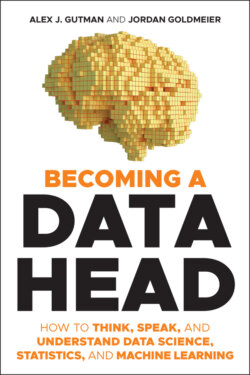Читать книгу Becoming a Data Head - Alex J. Gutman - Страница 50
DATA TYPES
ОглавлениеThere are many ways to encode information, but data workers use a few specific types of encodings that store information and communicate results. The two most common data types are described as numeric or categorical.
Numeric data is mostly made up of numbers but might use additional symbols to identify units. Categorical data is made up of words, symbols, phrases, and (confusingly) sometimes numbers, like ZIP codes. Numeric and categorical data both split into further subcategories.
There are two main types of numeric data:
Continuous data can take on any number in a number line. It represents a fundamentally uncountable set of values. Consider the weather. The outside temperature, if collected and turned into data, would represent a continuous variable. A local news station might measure a temperature of 65.62 Fahrenheit. However, they may choose to report this number to you as 65 degrees Fahrenheit, 66 degrees Fahrenheit, or 65.6 Fahrenheit.
Count (or discrete) data, unlike continuous data, restricts the precision of the data to a whole number. For example, the number of cars you own can be 0, 1, 2, or more, but not 1.23. This reflects the underlying reality of the thing being measured.1
Categorical data also has two main types:
Ordered (or ordinal) data is categorical data with an inherent order. Surveys, for example, take advantage of ordinal data when they ask you to rate your experience from 1−10. While this looks like count data, it's not possible to say the difference between survey ratings 10 and 9 is the same as the difference between 1 and 0. Of course, ordinal categorial data does not have to be encoded as numbers. Shirt size, for example, is ordinal: small, medium, large, extra-large.
Unordered (or nominal) categorical data does not have an underlying order to follow. Table 2.1, for example, has a Location feature with values Print, Online, Television. Other nominal variables include Yes or No responses; or Democrat or Republican party affiliation. Their order as presented is always arbitrary—it's not possible to say one category is “greater than” another.
You'll notice Table 2.1 has a Date feature, which is an additional data type that is sequential and can be used in arithmetic expressions like numeric data.
